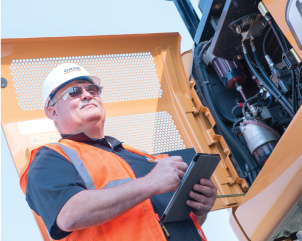Best Practices
Machine Winterization
Follow these best practices to make sure your machine is ready for winter.
Check chain tanks, final drives, swing gear baths and gear boxes for water
Check the label to make sure you're using coolant that complies with ASTM standard D-621, with
a freeze point low enough for your climate. If coolant freezes, it can crack the engine block and
ruin the engine.
Add fuel conditioner
Fuel conditioner prevents your fuel from freezing and makes sure your engine starts in the
cold. Check the manufacturer's recommendations for the amount of conditioner required.
Match the fuel conditioner to the type of fuel you're using (e.g., low sulfur).
Check the fuel filter
If the fuel filter is clogged, moisture can build up and freeze in the winter, causing your
machine to run improperly or fail to start. Empty the water traps in the filters before cold
weather arrives. To avoid downtime, keep an extra set of fuel filters in your cab.
Check cold start aids
Diesel engines spray ether into the air system to help the engine start in cold weather. For
older machines that have ether spray bottles, check the bottle to make sure it isn't empty.
For new machines with an automatic ether system, inspect the connections and hoses for
cracks or loose connections.
Check the block heater
Block heaters keep fluids at the right temperature and viscosity. If it isn't working, the oil can
thicken, so it's harder to turn the engine over and adds stress on the battery. Plug in the
block heater to check it, then touch the hoses to make sure they are warm.
Inspect air pre-cleaners
Large dust particles and debris can build up during the summer and should be removed.
Otherwise, snow and ice could collect around them, allowing moisture into the air system,
which could cause engine failure.
Check battery and connections
Corrosion around battery connections causes less voltage to be transmitted, and increases the
strain on the battery. Corroded connections can drain the battery, preventing your machine from
starting. Periodic inspections for corrosion reduce the chance of having a drained battery.
Winter Storage
Top off the fuel tank if possible
If you have a diesel engine, leave it completely full during winter months to eliminate
possibility of condensation forming in the fuel tank and spreading. Condensation can
clog the fuel filter, which can clog fuel lines, carburetors, and injectors.
Run the engine after cleaning
Run your machine's engine after cleaning the engine and replacing the oil so that a
protective film of oil coats the internal parts. The oil coating acts as a rust preventative. Pour
a 50/50 mixture of water and antifreeze into the coolant system before running as well to
protect the cooling system to -34°F.
Clean & fully charge batteries, then disconnect the power leads
Never store discharged batteries. Colder temperatures slow the discharge rate of fully
charged batteries.
Start machines once a month
Avoid starting the machines in extreme cold weather. Find a time when temperature is above
freezing to start the machine and operate the hydraulics for a brief time.
Do not try to break crawler type machines from a badly frozen situation.
The result can be power train damage.
Cold Weather Operation
Protect your machine
If you can't keep your machine inside when it's not in use, at least keep a weather resistant tarp over
the engine. With snow comes condensation, which can cause problems for the entire engine.
Manage productivity
Cold weather makes the earth harder, and frost can penetrate roadways and aggregates to
make utility, road, and crushing jobs much more difficult and time consuming. Winter months
have less daylight, so manage your time wisely.
Keep the jobsite clean
It is imperative to keep jobsites neat and clean during winter months. When not working,
leave a layer of snow on the ground to keep frost from penetrating the ground — the snow
will actually insulate the ground beneath. When working, make sure to clear all snow and ice
to avoid accidents.
Clean areas designated for snow removal
Clean up debris or equipment that will be hidden by fallen snow. Mark any areas of concern
with reflective stakes so snow removal crews can easily identify & stay away from those areas.
Plan for earthworks projects
Frozen chunks of ground need to be placed in designated areas. The frozen chunks of earth
contain water that can cause major problems in the spring, such as sink holes.
Use the best fuel
Make sure you are using high quality winter diesel fuel. The fuel conditioner should match
the type of fuel you are using (e.g., low sulfur) and should be approved by manufacturer.
Check starting devices
Make sure block heaters and cold weather starting devices are working properly.
Warm up the machine
Let machines come up to operating temperature before working.
Keep a spare fuel filter
Keep an extra fuel filter in the cab, and follow installation instructions in your
operator's manual.
Check ice build up
Check for Ice or snow build up in exhaust or intake if applicable. Inspect and clear ice or
snow from throttle and brake area.
Warm up to improve steering response
Steering response on equipment with hydraulic steering may become very slow at low
temperatures, even when the correct oils are used. Once the engine is started, let the
machine idle until the engine reaches operating temperature.
Stay aware of safety
Mount and dismount your machine using three points of contact. Remember that you are
working with snow and ice slips and falls are a common cause of injuries. Wear your seatbelt
when operating equipment and stay alert.
Looking for specialized winter equipment? Talk to our rental experts today!

